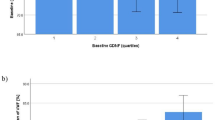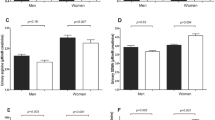Abstract
Chronically elevated blood pressure has been associated with impaired NO-mediated vasodilation and structural vascular disease risk. This study aimed to determine whether significant associations exist regarding NO metabolite (NOx) responses, cardiovascular function and structural vascular disease in a cohort of African and Caucasian men. The study included 81 African and 94 Caucasian male teachers stratified via median splits into low and high NOx ethnic groups. Ambulatory blood pressure, electrocardiogram monitoring and ultrasound carotid intima-media thickness (CIMT) images were obtained. Cardiovascular measurements and fasting blood for NOx responses were measured during rest and on challenging the cardiovascular system with the Stroop colour-word conflict test. African men displayed significantly higher resting NOx as well as higher number of 24 h silent ischemic events than their Caucasian counterparts. Low NOx African men displayed enhanced α-adrenergic and ECG ST segment depression acute mental stress responses as well as 24 h silent ischemic events associated with CIMT (adjusted R2=0.47; β=0.25; confidence interval (CI)=0.13, 0.41). African men demonstrated a vulnerable cardiovascular profile. Novel findings revealed α-adrenergic-driven blood pressure responses and less NO bioavailability during acute stress. The association between myocardial ischemia and CIMT in this group emphasized their risk for future coronary artery disease and cerebrovascular events.
This is a preview of subscription content, access via your institution
Access options
Subscribe to this journal
Receive 12 digital issues and online access to articles
$119.00 per year
only $9.92 per issue
Buy this article
- Purchase on Springer Link
- Instant access to full article PDF
Prices may be subject to local taxes which are calculated during checkout



Similar content being viewed by others
References
Sliwa K, Wilkinson D, Hansen C, Ntyintyane L, Tibazarwa K, Becker A . Spectrum of heart disease and risk factors in a black urban population in South Africa (the Heart of Soweto Study): a cohort study. Lancet 2008; 371: 915–922.
Van Rooyen JM, Kruger HS, Huisman HW, Wissing MP, Margetts BM, Venter CS et al. An epidemiological study of hypertension and its determinants in a population in transition: the THUSA study. J Hum Hypertens 2000; 14: 779–787.
Malan L, Schutte AE, Malan NT, Wissing MP, Vorster HH, Steyn HS et al. Specific coping strategies of Africans during urbanization: comparing cardiovascular responses and perception of health data. Biol Psychol 2006; 72: 305–310.
Toda N, Nakanishi-Toda M . How mental stress affects endothelial function. Pflügers Archiv Europ J Physiol 2011; 462 (6): 1–16.
Toda N, Tanabe S, Nakanishi S . Nitric oxide-mediated coronary flow regulation in patients with coronary artery disease: recent advances. Int J Angiol 2011; 20: 121–134.
Napoli C, Ignarro LJ . Nitric oxide and atherosclerosis. Nitric Oxide 2001; 5: 88–97.
Schächinger V, Zeiher A . Atherosclerosis-associated endothelial dysfunction. Z Kardiol 2000; 89: 70–74.
Cardillo C, Kilcoyne CM, Cannon RO, Panza JA . Racial differences in nitric oxide–mediated vasodilator response to mental stress in the forearm circulation. Hypertension 1998; 31: 1235–1239.
Widlansky ME, Gokce N, Keaney JF, Vita JA . The clinical implications of endothelial dysfunction. J Am Coll Cardiol 2003; 42: 1149–1160.
Obrist PA . Cardiovascular Psychophysiology: A Perspective. Plenum Press: New York, 1981.
MacArthur JD, MacArthur CT Laboratory Tasks for Cardiovascular Reactivity Research. 2001; Available at: http://www.macses.ucsf.edu/research/psychosocial/reactivity.php Accessed on 18 June 2009.
Opie LH . Heart Physiology: From Cell to Circulation 4th edn. Lippincott Williams & Wilkins: Philadelphia, 2004.
Liang Y, Teede H, Kotsoupoulos D, Shiel L, Cameron JD, Dart AM et al. Non-invasive measurements of arterial structure and function: repeatability, interrelationships and trial sample size. Clin Sci 1998; 95: 669–679.
Mancia G, De Backer G, Dominiczak A, Cifkova R, Fagard R, Germano G et al2007 Guidelines for the management of arterial hypertension: The Task Force for the Management of Arterial Hypertension of the European Society of Hypertension (ESH) and of the European Society of Cardiology (ESC). J Hypertens 2007; 25 (6): 1105–1187.
Rosvall M, Janzon L, Berglund G, Engström G, Hedblad B . Incidence of stroke is related to carotid IMT even in the absence of plaque. Atherosclerosis 2005; 179: 325–331.
Marfell-Jones M, Olds T, Steward A . Carter, JEL. International Standards for Anthropometric Assessment. ISAK: New Zealand, 2006.
Mosteller RD . Simplified calculation of body-surface area. N Engl J Med 1987; 317 (17): 1098.
Uen S, Fimmers R, Weisser B, Balta O, Nickenig G, Mengden T . ST segment depression in hypertensive patients: a comparison of exercise test versus Holter ECG. Vasc Health Risk Manag 2008; 4: 1073–1080.
Guy D . Pocket Guide to ECG's 2nd edn. McGraw-Hill: Sydney, Australia, 2006.
Dart AM, Kingwell BA . Pulse pressure—a review of mechanisms and clinical relevance. J Am Coll Cardiol 2001; 37: 975–984.
Sharpe PC . Biochemical detection and monitoring of alcohol abuse and abstinence. Ann Clin Biochem 2001; 38 (6): 652–664.
Jarvis MJ, Feyerabend C, Bryant A, Hedges B, Primatesta P . Passive smoking in the home: plasma cotinine concentrations in non-smokers with smoking partners. Tob Control 2001; 10: 368–374.
Kroenke K, Spitzer RL, Williams JBW . Validity of a brief depression severity measure. J Gen Intern Med 2001; 16: 606–613.
Lloyd-Jones DM, Liu K, Tian L, Greenland P . Narrative review: assessment of C-reactive protein in risk prediction for cardiovascular disease. Ann Intern Med 2006; 145: 35–43.
Walsh T, Donnelly T, Lyons D . Impaired endothelial nitric oxide bioavailability: a common link between aging, hypertension, and atherogenesis? J Am Geriatr Soc 2009; 57: 140–145.
Guyton AC, Hall JE . Textbook of Medical Physiology 12th edn. Elsevier Inc: Philadelphia, Pennsylvania, USA, 2010.
Van Lill L, Malan L, Van Rooyen J, Steyn F, Reimann M, Ziemssen T . Baroreceptor sensitivity, cardiovascular responses and ECG left ventricular hypertrophy in men: the SABPA study. Blood Press 2011; 20: 355–361.
Verma S, Anderson TJ . The ten most commonly asked questions about endothelial function in cardiology. Cardiol Rev 2001; 9: 250–252.
Rosengren A, Hawken S, Ôunpuu S, Sliwa K, Zubaid M, Almahmeed WA et al. Association of psychological risk of acute myocardial infarction in 11 119 cases and 13 648 controls from 52 countries (the INTERHEART study): case-control study. Lancet 2003; 364: 953–962.
Van der Wal AC, Becker A, Van der Loos C, Das P . Site of intimal rupture or erosion of thrombosed coronary atherosclerotic plaques is characterized by an inflammatory process irrespective of the dominant plaque morphology. Circulation 1994; 89: 36–44.
Behrendt D, Ganz P . Endothelial function: from vascular biology to clinical applications. Am J Cardiol 2002; 90: L40–L48.
Napoli C, Ignarro LJ . Nitric oxide and pathogenic mechanisms involved in the development of vascular diseases. Arch Pharm Res 2009; 32: 1103–1108.
Drexler H . Nitric oxide and coronary endothelial dysfunction in humans. Cardiovasc Res 1999; 43: 572–579.
Quyyumi AA, Dakak N, Andrews NP, Husain S, Arora S, Gilligan DM et al. Nitric oxide activity in the human coronary circulation. Impact of risk factors for coronary atherosclerosis. J Clin Invest 1995; 95: 1747–1755.
Mojiminiyi O, Abdella N, Moussa M, Akanji A, Al Mohammedi H, Zaki M . Association of C-reactive protein with coronary heart disease risk factors in patients with type 2 diabetes mellitus. Diabetes Res Clin Pract 2002; 58: 37–44.
Pizzi C, Manzoli L, Mancini S, Bedetti G, Fontana F, Costa GM . Autonomic nervous system, inflammation and preclinical carotid atherosclerosis in depressed subjects with coronary risk factors. Atherosclerosis 2010; 212: 292–298.
Acknowledgements
We thank the participants of the SABPA study as well as the members of PhasRec (anthropometric measurements), M Glyn (NOx analysis), C Lessing (data collection) and S Péter (data collection) for their invaluable input. This study was supported by North-West University (Potchefstroom), North-West Department of Education, Roche Diagnostics, National Research Foundation (UID 65607), South Africa and the Metabolic Syndrome Institute, France.
Author information
Authors and Affiliations
Corresponding author
Ethics declarations
Competing interests
The authors declare no conflict of interest.
Rights and permissions
About this article
Cite this article
Uys, A., Malan, L., van Rooyen, J. et al. Attenuated NOx responses and myocardial ischemia, a possible risk for structural vascular disease in African men: the SABPA study. J Hum Hypertens 28, 438–443 (2014). https://doi.org/10.1038/jhh.2013.128
Received:
Revised:
Accepted:
Published:
Issue Date:
DOI: https://doi.org/10.1038/jhh.2013.128



